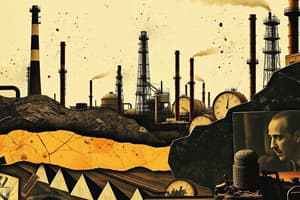Podcast
Questions and Answers
What is the primary focus of the first module in the course?
What is the primary focus of the first module in the course?
- Performance evaluation techniques
- Combustion fundamentals
- Characterization of fuel (correct)
- Boiler technology for bioenergy
How many hours are dedicated to learning about combustion fundamentals?
How many hours are dedicated to learning about combustion fundamentals?
- 24 Hours
- 14 Hours (correct)
- 10 Hours
- 6 Hours
Which equipment is specifically used to measure the energy content of biofuel?
Which equipment is specifically used to measure the energy content of biofuel?
- Gas Chromatograph
- Proximate Analyzer
- Bomb Calorimeter (correct)
- Thermogravimetric Analyzer
What percentage of the overall assessment does the Final Assessment constitute?
What percentage of the overall assessment does the Final Assessment constitute?
What is measured in the Proximate Analyzer during laboratory sessions?
What is measured in the Proximate Analyzer during laboratory sessions?
What is the primary benefit of using a bomb calorimeter for estimating the calorific value of fuel?
What is the primary benefit of using a bomb calorimeter for estimating the calorific value of fuel?
Which equation represents the relationship between heat given by the fuel and heat gained by water?
Which equation represents the relationship between heat given by the fuel and heat gained by water?
What type of calorific value is determined using the bomb calorimeter?
What type of calorific value is determined using the bomb calorimeter?
In the calculation for calorific value, which of the following is NOT included in the total heat absorbed?
In the calculation for calorific value, which of the following is NOT included in the total heat absorbed?
What component is primarily responsible for cooling the hot gases in a bomb calorimeter?
What component is primarily responsible for cooling the hot gases in a bomb calorimeter?
How is the net calorific value (NCV) of a fuel calculated from its gross calorific value (GCV)?
How is the net calorific value (NCV) of a fuel calculated from its gross calorific value (GCV)?
What is the significance of the excess oxygen supplied in the bomb calorimeter?
What is the significance of the excess oxygen supplied in the bomb calorimeter?
Which of the following statements accurately describes the heat loss correction in measurements?
Which of the following statements accurately describes the heat loss correction in measurements?
What is the process of combustion?
What is the process of combustion?
What is the primary difference between Gross Calorific Value (G.C.V) and Net Calorific Value (N.C.V)?
What is the primary difference between Gross Calorific Value (G.C.V) and Net Calorific Value (N.C.V)?
What device is used to determine the calorific value of a fuel?
What device is used to determine the calorific value of a fuel?
Which of the following statements about biomass combustion technologies is accurate?
Which of the following statements about biomass combustion technologies is accurate?
What is the formula to calculate Net Calorific Value (N.C.V)?
What is the formula to calculate Net Calorific Value (N.C.V)?
Which principle is used by calorimeters to determine calorific value?
Which principle is used by calorimeters to determine calorific value?
What is a key goal of applying combustion principles in bio-based thermal energy generation?
What is a key goal of applying combustion principles in bio-based thermal energy generation?
In the context of biomass combustion, which of the following aspects is crucial for evaluating performance?
In the context of biomass combustion, which of the following aspects is crucial for evaluating performance?
How does moisture affect the heat loss in fuels?
How does moisture affect the heat loss in fuels?
What is the primary component of fixed carbon?
What is the primary component of fixed carbon?
What impact does high ash content have on fuel?
What impact does high ash content have on fuel?
What is the effect of moisture content on the heating value of a fuel?
What is the effect of moisture content on the heating value of a fuel?
How does volatile matter influence the burning of coal?
How does volatile matter influence the burning of coal?
What is torrefaction and how does it affect wood fuel quality?
What is torrefaction and how does it affect wood fuel quality?
What happens to the combustion process when moisture content exceeds 55wt%?
What happens to the combustion process when moisture content exceeds 55wt%?
What does a higher fixed carbon content indicate regarding the heating value of coal?
What does a higher fixed carbon content indicate regarding the heating value of coal?
What is the relationship between fixed carbon composition and heating value in coal compared to wood?
What is the relationship between fixed carbon composition and heating value in coal compared to wood?
Which elements are included in the ultimate analysis of fuels?
Which elements are included in the ultimate analysis of fuels?
How does volatile matter content affect combustion efficiency?
How does volatile matter content affect combustion efficiency?
What is the ignition point of a fuel?
What is the ignition point of a fuel?
What best describes the flash point of liquid biofuels?
What best describes the flash point of liquid biofuels?
What factors influence the ignition temperature of fuels?
What factors influence the ignition temperature of fuels?
Which statement about biomass feedstock is correct?
Which statement about biomass feedstock is correct?
What does combustion efficiency measure?
What does combustion efficiency measure?
Flashcards are hidden until you start studying
Study Notes
Course Overview
- Course: BST 31212 - Combustion Technologies for Bioenergy
- Duration: 06 hours for fuel characterization, 14 hours for combustion fundamentals, 10 hours for boiler technology
- Assessment breakdown: 40% Continuous Assessment, 60% Final Assessment
- Practical components include energy audit of biomass boiler (24 hours) and laboratory sessions for calorific value measurements
Learning Outcomes
- Identify various biofuels and their combustion traits
- Understand biomass combustion technologies and practical applications
- Apply combustion principles for generating bio-based thermal energy
- Operate and maintain low pressure steam boilers
- Evaluate biomass combustion performance
Combustion Fundamentals
- Combustion is the burning of a substance in air/oxygen, producing light and heat
- Calorific Value: Heat released per unit mass or volume of fuel
- Gross/High Calorific Value (G.C.V/H.C.V): Total heat when fuel fully combusted and cooled
- Net/Low Calorific Value (N.C.V/L.C.V): Total heat minus latent heat of vaporized water
Measuring Calorific Value
- Bomb calorimeter used for calorific value determination
- Heat transfer from combustion to water and container determines calorific value
- Complete combustion achieved due to high oxygen pressure and correction for temperature loss ensures accuracy
Calorific Value Calculations
- Heat given by fuel equals heat gained by water, structured as:
m1 * CV = m2 * specific heat of water * (T2 - T1) - Total heat output from fuel includes contributions from fuse wire and cotton thread
Impact of Fuel Composition
- Ash Content: Non-burnable impurities that increase handling costs, decrease combustion efficiency
- Volatile Matter: Includes flammable gases aiding ignition and combustion; influences flame length and furnace architecture
- Fixed Carbon: Solid fuel remaining post-volatilization primarily affects heating value
Proximate and Ultimate Analysis
- Proximate analysis evaluates moisture, ash, volatile matter, fixed carbon
- Ultimate analysis examines chemical properties (C, H, O, N, S content) of the fuel
- Biomass consists mainly of cellulose, hemicellulose, lignin, and varying nitrogen and sulfur
Combustion Efficiency
- Defined as heat released by fuel relative to heat input
- Influencing factors include type of fuel, bed temperature, gas velocity, and excess air levels
- Higher volatile matter content generally increases combustion efficiency
Ignition and Flash Points
- Ignition Point: Minimum temperature for continuous combustion without external heat, varies with fuel volatility and other conditions
- Flash Point: Minimum temperature for combustion to commence with external heat; dependent on fuel characteristics, not solely on ignition source temperature
Studying That Suits You
Use AI to generate personalized quizzes and flashcards to suit your learning preferences.




